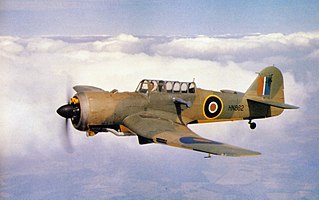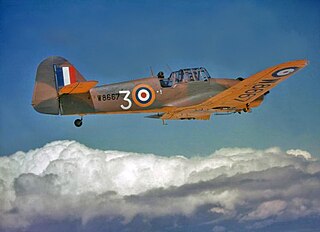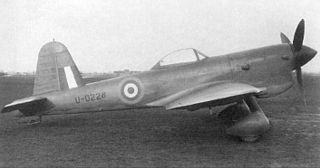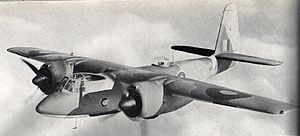
The Blackburn Roc was a naval fighter aircraft designed and produced by the British aviation company Blackburn Aircraft. It took its name from the mythical bird of the tales of the Arabian Nights, the Roc. It was operated by the Fleet Air Arm (FAA) and was active during the Second World War.

The Fairey Albacore is a single-engine biplane torpedo bomber designed and produced by the British aircraft manufacturer Fairey Aviation. It was primarily operated by the Royal Navy Fleet Air Arm (FAA) during the Second World War.

The Boulton Paul Defiant is a British interceptor aircraft that served with the Royal Air Force (RAF) during World War II. The Defiant was designed and built by Boulton Paul Aircraft as a "turret fighter" to meet the RAF requirement for day and night fighters that could concentrate their firepower on enemy bombers which were not expected to have fighter escorts due to the distance from Germany to the United Kingdom. The Defiant had all its armament in a dorsal turret offering the ability to fire in most directions. The same principle was used in the Royal Navy's Blackburn Roc which was also built by Boulton Paul.

The Miles M.25 Martinet was a target tug aircraft of the Royal Air Force (RAF) and Fleet Air Arm (FAA) that was in service during the Second World War. It was the first British aircraft to be designed specifically for target towing.

The Miles M.9 Master was a British two-seat monoplane advanced trainer designed and built by aviation company Miles Aircraft Ltd. It was inducted in large numbers into both the Royal Air Force (RAF) and Fleet Air Arm (FAA) during the Second World War.

The Fairey Seafox was a 1930s British reconnaissance floatplane designed and built by Fairey for the Fleet Air Arm. It was designed to be catapulted from the deck of a light cruiser and served in the Second World War. Sixty-six were built, with two finished without floats and used as landplanes.

The Blackburn B-24 Skua was a carrier-based low-wing, two-seater, single-radial engine aircraft by the British aviation company Blackburn Aircraft. It was the first Royal Navy carrier-borne all-metal cantilever monoplane aircraft, as well as the first dive bomber in Fleet Air Arm (FAA) service. The aircraft took its name from the sea bird which 'divebombs' any potential predators that come too close to its nest.

The Hawker Henley was a British two-seat target tug derived from the Hawker Hurricane that was operated by the Royal Air Force during the Second World War.

The Miles M.20 was a Second World War British fighter developed by Miles Aircraft in 1940. It was designed as a simple and quick-to-build "emergency fighter" alternative to the Royal Air Force's Spitfires and Hurricanes should their production become disrupted by bombing expected in the anticipated German invasion of the United Kingdom. Due to the subsequent shifting of the German bombing effort after the Battle of Britain towards British cities in what became known as The Blitz, together with the dispersal of British fighter manufacturing, the Luftwaffe's bombing of the original Spitfire and Hurricane factories did not seriously affect production, and so the M.20 proved unnecessary and the design was not pursued.

The Martin Model 167 Maryland was an American light bomber that first flew in 1939. It saw action in World War II with France and the United Kingdom.

The de Havilland DH.91 Albatross was a four-engined British transport aircraft of the 1930s manufactured by de Havilland Aircraft Company Limited. Seven aircraft were built between 1938 and 1939.

The Curtiss SC Seahawk was a scout seaplane designed by the Curtiss Aeroplane and Motor Company for the United States Navy during World War II. The existing Curtiss SO3C Seamew and Vought OS2U Kingfisher were gradually replaced by the Seahawk in the late stages of the war and into peacetime.

The Breda Ba.88 Lince ("Lynx") was a ground-attack aircraft used by the Italian Regia Aeronautica during World War II. Its streamlined design and retractable undercarriage were advanced for the time, and after its debut in 1937 the aircraft established several world speed records. However, when military equipment was installed on production examples, problems of instability developed and the aeroplane's general performance deteriorated. Eventually its operational career was cut short, and the remaining Ba.88 airframes were used as fixed installations on airfields to mislead enemy reconnaissance. It represented, perhaps, the most remarkable failure of any operational aircraft to see service in World War II.

The Blackburn Firebrand was a British single-engine strike fighter for the Fleet Air Arm of the Royal Navy designed during World War II by Blackburn Aircraft. Originally intended to serve as a pure fighter, its unimpressive performance and the priority allocation by the Ministry of Aircraft Production of Napier Sabre engines to the Hawker Typhoon caused it to be redesigned with an alternate engine as a strike fighter to take advantage of its load-carrying capability. Development was slow and the first production aircraft was not delivered until after the end of the war. Only a few hundred were built before it was withdrawn from front-line service in 1953.

The Miles M.38 Messenger is a British four-seat liaison and private owner aircraft built by Miles Aircraft.

The Short Sturgeon was a planned British carrier-borne reconnaissance bomber whose development began during Second World War with the S.6/43 requirement for a high-performance torpedo bomber, which was later refined into the S.11/43 requirement which was won by the Sturgeon. With the end of the war in the Pacific production of the aircraft carriers from which the Sturgeon was intended to operate was suspended and the original reconnaissance bomber specification was cancelled.

The Blackburn B.26 Botha was a four-seat reconnaissance and torpedo bomber. It was produced by the British aviation company Blackburn Aircraft at its factories at Brough and Dumbarton.

The Gloster F.9/37, also known as the Gloster G.39, was a British twin-engined design from the Gloster Aircraft Company for a cannon-armed heavy fighter to serve with the Royal Air Force, planned before the Second World War. The F.9/37 was rejected in favour of other designs.

The Westland Wallace was a British two-seat, general-purpose biplane of the Royal Air Force, developed by Westland as a follow-on to their successful Wapiti. As the last of the interwar general purpose biplanes, it was used by a number of frontline and Auxiliary Air Force Squadrons. Although the pace of aeronautical development caused its rapid replacement in frontline service, its useful life was extended into the Second World War with many being converted into target tugs and wireless trainers. In 1933 a Westland Wallace became the first aircraft to fly over Everest, as part of the Houston-Mount Everest Flight Expedition.

The Miles M.3 Falcon is a 1930s British three/four-seat cabin monoplane aircraft designed by Miles Aircraft Limited.




















